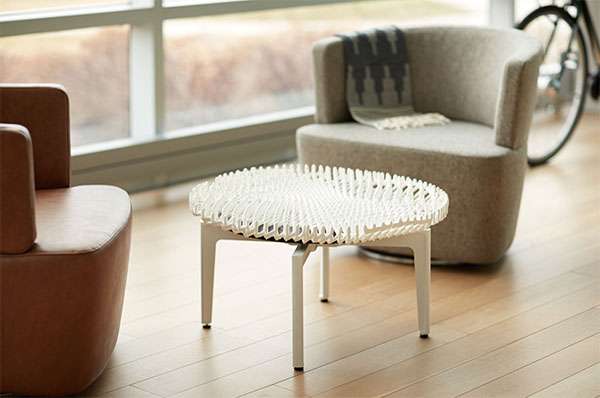May 18, 2017 weblog
Office furniture sends Milan design vibes as collab experiments with Rapid Liquid Printing

An innovative exploration by researchers at MIT and Grand Rapids, Michigan-based furniture company Steelcase has resulted in a promising vision of furniture made via 3D printing. The developers, from MIT's Self-Assembly Lab and Steelcase are talking about their technique.
Self-Assembly Lab said that, in collaboration with Steelcase, they are presenting the experimental process called Rapid Liquid Printing. Dan Howarth in Dezeen described Rapid Liquid Printing, "which involves extruding material from a computer-controlled nozzle into gel."
This technique injects material into a supportive gel and can print much larger objects than previously possible—and in minutes.
Lab director Skylar Tibbits told Dezeen: "In the beginning we started with this question: could you print furniture in minutes? If you look at printing from that perspective it forces you to think about it in a completely different way."
Rapid Liquid Printing can deliver furniture or other items in minutes, they said—using rubber, foam, or plastic or any other industrial liquid material.
If this gains traction, two worlds would get a shakeup. The sight of some office furnishings can make one tired long before the clock strikes 5 pm.
This process could unleash more creativity for office planners, in customizing pieces.
Also, 3D printing itself would overcome some limitations.
In a video, the Self-Assembly Lab discussed what three characteristics are lacking in 3D printing as a mainstream manufacturing process. Speed. Size. Materials.
The speed is too slow. compared to conventional processes like injection molding, casting and milling. The size is too small. Although it's good for creating small components, the production of large scale objects is another story. Another limitation they counted involved materials of poor quality compared to industrial materials.
Speaking about Rapid Liquid Printing, Self Assembly Lab said, "Compared with other techniques we believe this is the first development to combine industrial materials with extremely fast print speeds in a precisely controlled process to yield large-scale products."
Alexandru Micu in ZME Science spelled out what is interesting about their approach, which "forgoes the layer-by-layer approach of traditional 3D printing methods and instead injects material directly into a vat of supportive gel."
"The injection head essentially 'draws' the object inside the vat, with the gel providing buoyancy and maintaining the shape of the object while it hardens."
The technique provides room for designer creativity. Micu noted that altering the speed of injection and speed at which the head travels through the gel alters the thickness of lines laid down by the device, "allowing for a huge range of shapes to be created."
Rebecca Charbauski in the Steelcase company blog wrote that the collab also involved product designer Christophe Guberan.
She also said that this printing inside a gel allowed a designer "to draw in 3D space without the limitations of gravity. Because there is no traditional support material and structure or layering, the printing process is much faster and can be as big as the machine available."
Elaborating further, she said a two-part mixing process was at play, which allows the material to be chemically cured, rather than set using light or temperature. "The technique mixes, extrudes and cures all while the 3D printing is underway."
What impact could this Rapid Liquid Printing have in the real world? Its presence might be felt in the furniture business and in office environments.
The process could have beneficial outcomes in encouraging more personalization in furniture products and opportunities for customization. Designers might see more opportunities to innovate.
People are rejecting the stereotypical, monolithic office their employers are creating, said Charbauski. Work environments that allow for furniture customization can increase a person's sense of belonging, promote self-expression and authenticity.
The blog also carried a remark about Rapid Liquid Printing from Yuka Hiyoshi, industrial designer, commented that "it's not limited to typical 3D printing material making the technology very desirable from a design perspective."
What's next? Rapid Liquid Printing is in its experiment phase. Charbauski said the work continues to be in exploration. "The collaboration between Steelcase and MIT will continue to seek further answers regarding materials, scale and improved printing processes."
More information: www.selfassemblylab.net/RapidLiquidPrinting.php
© 2017 Tech Xplore


















